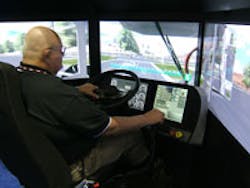I take the corner a little too fast, forcing me to widen the arc of my big rig‘s turn to prevent a rollover. The wheel is heavy by this point, sluggish from the full weight of the 53-foot trailer behind me. I get my tractor-trailer straightened out all right, but sideswipe a bobtailing tractor coming in the opposite direction. I do the same thing again to pickup truck further down the road as I try to navigate around a work zone that takes up most of the right lane. Hoo boy, this isn‘t a good day.
I hit the brakes too hard at a stoplight then gun the engine aggressively to make a left turn ahead of oncoming traffic, continuing to accelerate quickly down the road. Wait a minute: there‘s a bus parked up on the right. Is it a school or city bus? I jam on the brakes again, worried that children might start crossing the road - heck, I nearly ran over a guy earlier that darted into traffic to retrieve a wayward garbage can. The air brakes give out several loud hisses - doesn‘t help that I am speeding - as my rig jolts to a halt.
“OK, let‘s see what we got,” says Bill Graham, monitoring my progress on his laptop just over my right shoulder. Needless to say, my driving record is pretty poor as his computer lists all my hard braking events, aggressive acceleration, accidents, near misses, plus innumerable hit curbs and lane violations. On top of that, my average fuel economy hovered somewhere around 2.71 miles per gallon - pretty grim stuff all around.
And I forgot to set the parking brake, too. Good thing this is just a simulator.
Watch a video report on MPRI's Simulator.
You knew that was coming, of course - no way would any trainer keep me behind the wheel after not one but TWO sheet metal crunches a couple of minutes apart. But this wasn‘t a video game-style experience, either: not by a long shot. Though I got a tractor-trailer equipped with an automated transmission (just push ‘D‘ and go), the wheel didn‘t turn easily and my seat tilted and vibrated when I hit things.
(Bill Graham at the 'wheel' of MPRI's TranSim simulator)
The wrap-around screen of the TranSim VS IV simulator - built by MPRI, a division of the L3 Companies - also fooled my eyes into thinking we were actually moving, as it completely encompassed my peripheral vision. Electronically generated side view mirrors reflected all the events going on behind the trailer, to make backing up a very realistic enterprise.
In many ways, this is the wave of the future for truck driver training. Just like airline pilots must accrue thousands of hours worth of simulator time to retain their license to fly, so too will truck drivers one day be required to log simulator time to keep their CDLs. That‘s my belief. But there‘s more to it. Simulators are just such an easy way to quickly gauge a new driver‘s skill level, or help an experience hand switch to new kind of rig - going from a dry van trailer to say a tanker or flatbed. MPRI‘s simulator can quickly be reprogrammed for various trucks, too - school buses, trash trucks, medium-duty package vans, double trailers, you name it - depending on the software package.
Everything is realistic - from the other vehicles on the road, to the buildings, traffic signals, even the people (though MPRI‘s engineers stopped short of including screams and blood when a pedestrian gets hit). That is, of course, the point - to put truck drivers on the road without the risks to life, limb, and tractor-trailers that worth a big six figures.
Truckload carrier Schneider National started using these simulators back in 2004 and by its own estimates, the company figures it‘s lowered new driver dropout and termination rates by 10% and accident severity and frequency by nearly 20%. “Overall, the implementation of simulator-based training has saved us millions of dollars,” says Don Osterberg, Schneider‘s vice president of safety.
Graham, who watched my every move, told me simulator training is not just about making truck drivers safer, though that is the main point. “I showed you your mpg hovered around 2.71 - there‘s an area we could work on, in terms of how you brake, accelerate, and drive, whether you‘re using an automated or manual transmission,” he told me. “We can sit here and practice backing a truck up to a loading dock on a crowded city street for an hour - without tying up traffic, without exposing the trailer to damage. We can even unhook and re-hook the trailer. That‘s all about fine-tuning technique.”
(Bill Graham smoothly navigates his virtual rig around a digital corner)
Yes, simulators are expensive, costing several thousand dollars - again, it‘s no video game - but just compared that to the cost of accidents. According to the National Highway Traffic Safety Administration, the cost of fatal crash is $3.6 million, and $195,000 for one involving non-fatal injuries - not to mention the hit you take in terms of vehicle damage and higher insurance premiums. If simulator training can prevent even one accident, you‘re probably way ahead in the cost-saving arithmetic.
The there‘s the cost of turnover, hovering around $8,000 per driver today (that‘s all the advertising, training, and administrative dollars a fleet loses when a driver walks away). If these devices can help you cull applicants before they get behind the wheel in real time, helping you figure out who has the necessary skills and is cut out for the stresses of the road, suddenly simulators can seem to be a pretty cost effective retention tool.
It‘s fascinating technology, to be sure, with some big payoffs for truckers. It‘ll be interesting to see how many fleets start using them down the road.
